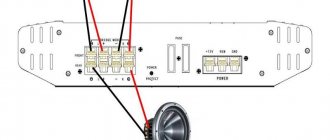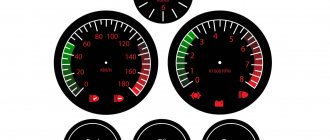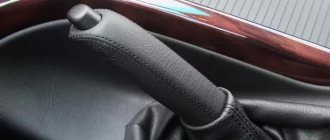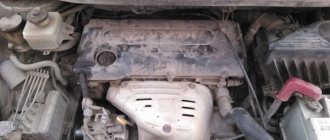Habit Formation
When starting to study the car industry, you should start with the formation of habits. It is known that habits are formed as a result of repeated repetition of something. If you need to remember something, you need to repeat it many times (or not so much, depending on the degree of assimilation).
If you need to master any exercise, then for the result you need, again, to repeat it several times. Each time it will turn out better and better.
This is how you develop the ability to memorize at the level of sensations, and subsequently many actions occur, as they say, “automatically.” A person explains this to himself - “I’m so used to it!”
So, from the very beginning of automotive practice, it is necessary to form the right habits in yourself. This is achieved by repeating the correct actions while driving every day.
What does the phrase “correct driving behavior” mean? How to understand which actions are right and which are wrong?
Without going into philosophy, the right actions are those that, while driving, lead to what you want, i.e. to the desired result, and this is achieved with the least effort and the least amount of body movements.
In other words, as a result of correct actions by the driver, the car moves in a given direction at the desired (specified) speed without jolts or jerks.
The correctness of actions is achieved by the fact that the driver sits behind the wheel, grips the steering wheel, directly steers, shifts gears, accelerates, decelerates the car, etc. always performed in the same way in a calm manner.
In a critical situation, the driver usually acts as he is accustomed to. Therefore, you also need to get used to it correctly. This is necessary, first of all, in order to bring car control to automaticity.
Steering wheel and gear shift knob
Some drivers practice the 10 and 2 o'clock positions, as this allows more force to be applied to the steering wheel. However, why invent a bicycle when today's cars are all equipped with power steering? This is one argument. And the second concerns security.
A typical mistake.
When you actively manipulate the steering wheel with your hands at 10/2 o'clock, the forces are distributed unbalanced. In this case, you control the car, but not completely. And what can we say about the drivers who drive their “swallow” with one hand, holding the other on the gearshift knob... This driving style puts everyone in the car at risk, since the would-be driver in the event of an emergency will not be able to quickly respond to changes in the road environment.
Golden Rule:
It is very important, regardless of the hand position used, to ensure a symmetrical grip on the steering wheel. And if you learn not to let go even when performing emergency maneuvers, everything will be fine! If we talk about intercepting the steering wheel, then it should be done one by one.
More about steering wheel adjustment.
In recent years, automakers have begun to offer steering wheels with vertical and horizontal adjustment. It would seem very convenient, if not for the large percentage of car owners who strive to tilt the steering column as close as possible to themselves, their loved one. Their considerations are quite clear: the closer the control, the better control over the machine. However, let's imagine what happens to such a driver at the time of the accident? If the steering wheel is closer than 35 cm to the body, then at the moment of an emergency, the airbag firing will cause considerable pain, or even cause injury. Therefore, it is highly recommended to tilt the steering wheel so that there is 35-40 cm to the chest - no more, no less...
Driver's position behind the wheel
The basis of all correct actions behind the wheel is landing. NOT the process of landing in the sense of how you get into the interior of the car, but the landing (position) behind the wheel while driving the car.
It should be comfortable to sit behind the wheel. Because The concept of “convenient” is perceived differently by people, it is necessary to clarify: it is convenient not for leafing through a magazine or looking at a tablet (phone).
The driver's position behind the wheel should be such that it is convenient to operate the control levers, conveniently observe the situation around the car, and respond in a timely manner to its changes.
The main control levers are the steering wheel, pedals, gear selector, auxiliary controls - all other “levers” that are somehow related to the control of the car as a whole.
How to make sure that you are sitting behind the wheel correctly = comfortably? To do this, you need to rest your back against the back of the chair (seat), fully depress the clutch pedal to the floor, and pay attention to the position of your arms and legs.
Adjust the seat so that the leg is not completely straightened, but slightly bent at the knee joint. In this case, the right hand should freely reach the gearbox shift lever in the position of the gear farthest from the driver (if the gearbox is manual).
The back remains pressed against the back of the seat and under no circumstances should it slide upward! If this happens, it means the backrest is too tilted. The seat back should be in an almost vertical position - an inclination of approximately 10 degrees.
A few words about backrest tilt. If you pay attention to how the drivers of passing cars sit, you can see options from “almost vertical” to “reclining.” It's probably so convenient for them. But these are their habits, not yours.
The position of the back “almost vertical, but with a slight tilt back” is justified by the physiology of the body. The fact is that the human vestibular apparatus works effectively only in this position (when the back is almost vertical).
Those. in this position, the brain correctly detects any deviation of the car: both vertical and horizontal, incl. deviation from the course of the front or rear axle of the car (drift or skid).
In the “reclining” position, the vestibular apparatus is activated with a delay, and the body’s departure from the course is also recorded with a delay, most often when it is already too late. And as a consequence of a late reaction - untimely application of countermeasures to avoid accidents. Draw conclusions.
The distance from the chest to the steering wheel is measured approximately like this: After adjusting the seat for ease of operation of the clutch and brake pedal, sit down and press your shoulder blades against the back of the seat. Bend the hand of either hand at the wrist, and place the bend on the top point of the steering wheel.
The curve of your wrist should lie flat on the rim of the steering wheel at its highest point. The arm should be naturally slightly bent at the elbow.
Next, you should place both hands on the steering wheel parallel to the horizontal axis, with a closed grip, in a position of approximately “10 minutes to 2”. Try to feel how comfortable it is to hold the steering wheel.
To better orient the position of your hands on the steering wheel, there is one way. Place your outstretched palms on the rim of the steering wheel, just above the horizontal axis, and twist them slightly in different directions. At some point, each of the palms will seem to fall into a hole. This steering wheel rim took its place in the palms.
Now you can squeeze your hands around the rim of the steering wheel - this will be your correct grip. In this case, do not squeeze the steering wheel too hard. The hands should not be tense. The angle between the shoulder and forearm with this grip and a correctly adjusted seat is approximately 120 degrees.
Car and spine
People have suffered from various diseases of the spine at all times, and the male population suffers from the spine much more. This is explained by men's work - drafts, heavy lifting.
Driving a car for a long time tires a person mentally and physically, and also causes spinal diseases. Doctors have found that drivers often sit in the car incorrectly. This is usually a pose where the body is tilted forward and the legs are extended. In the spine, this increases the force on the intervertebral discs. They get worse due to frequent shaking. As a result, diseases such as spondylolisthesis, osteochondrosis and others appear. If you have a herniated disc in your spine, doctors do not recommend driving at all.
The main cause of osteochondrosis for drivers is insufficient motor mode, which is called physical inactivity. Driving conditions are characterized by overstrain of the muscles of the shoulders and legs. Such a constant load over many years contributes to the occurrence of various diseases.
Spinal disc herniation is the most common disease in this area. It is associated with disruption of metabolic processes in the disks.
To maintain your health and not give up driving a car if you have a herniated disc, you need to learn how to sit behind the wheel:
- The driver's seat is the key to health. It is better if it is equipped with back support to prevent lower back pain. This device should be located at the bottom and adjustable in tilt and height.
- Every two hours you need to stop and stretch your back, walk, do some exercises, and at the same time inspect the car.
- You need to sit straight, with your back resting on the back of the chair.
- The presence of a headrest is mandatory to prevent injury to the cervical spine during sudden car impacts.
Feet position while driving
Next, we place the legs. The clutch pedal is for the left foot, the gas and brake pedals are for the right. The heel of the right foot is located on the floor between the gas and brake pedals, the toe of the right foot rests on the gas, and the knee freely “leans” to the right.
Later, you will need to learn how to quickly move your right foot from the gas to the brake.
Some cadets at the training stage try to press the brake with their left foot. This is a big mistake! You either accelerate the car by pressing the gas (with your right foot) or you brake (slow down) by pressing the brake (again with your right foot).
It is advisable to place your left foot on the foot rest (small platform to the left of the clutch pedal) so that you can move your foot from the rest to the clutch pedal at any time. If there is no such support, then simply place your heel on the floor and rest your foot on the arch of the front wheel, so that it is comfortable for you.
What you absolutely cannot do is keep your left foot on the clutch pedal (many beginners try to do this). In this case, the leg will quickly get tired, and in addition, you can “burn” the clutch, since your foot on the pedal will “eliminate” its free play.
It is also not recommended to place your left foot on the floor, under the clutch pedal - from this position it is not always possible to quickly put your foot on the pedal.
Of course, if the car is equipped with an automatic transmission, then the left foot does not even have to be removed from the rest.
Advice from professionals
When the driver sits low with his back pushed very far back, he actually cannot see what is happening in front of the hood. That is, it limits your own visibility, and this is very unsafe.
Therefore, you need to correctly set, first of all, the height of the chair and the seating depth. If your car has eclectic seat adjustment, this simplifies our task.
There are two motors here that lower the seat along the plane. That is, you can omit the fifth point.
The most important thing here is that our main artery through which blood flows, the groin, is not compressed.
That is, if the fifth point is deeply planted, then the legs are raised, it turns out that the angle between the body and the thigh will decrease, it will become less than 90 degrees. This is not acceptable because the legs will become numb and numb. Accordingly, sensitivity is lost from this.
Also, on the one hand, you need to sit high enough to have a good view, and on the other, not very close to the ceiling.
The distance between the ceiling and the head should be at least 8-10 cm. Thus, in the event of a possible rollover of the car on its side or onto the roof, while fastened, you will not reach the ceiling and break your cervical vertebrae. Therefore, this gap should exist.
The correct seating position can also be adjusted using the pedals. The driver should reach the brake pedal with a slightly bent right leg, but it is also important at what point the heel should rest on the floor.
If you have a car with an automatic transmission, where there are only two pedals, brake and gas, then your right foot should lie between the pedals. This will reduce the time it takes to reach one or another pedal. And if we are talking about a beginner, then his foot should lie against the brake pedal.
Since in a critical situation the driver intuitively rests his feet on the floor, and then the right foot will clearly press the brakes.
Adjusting rear view mirrors
Rear view mirrors are flat, spherical or panoramic. A spherical or panoramic mirror is a slightly curved mirror, and you can see a little more through it than through a straight one.
Which one to give preference to is a matter of taste, you can try both, but as experts say, at least one mirror in the car should be straight. Why is this so?
The fact is that spherical mirrors move the picture away, thereby distorting the distance to those who are behind you. You will first need to get used to such mirrors, while at the same time taking into account the distance.
Direct mirrors are more “honest”, although they have less visibility. And don’t forget about the so-called “dead (blind)” spots of the car. These are the areas that are not visible in the mirrors. Therefore, in different situations you will still have to turn your head.
The mirrors should be adjusted in this way: in the interior mirror the rear window should be completely visible, preferably including the right rear window, and in the side rear view mirror the road and a little of the rear wing of the car should be visible. The horizon line in reflection runs through the middle of the mirror.
The Importance of Proper Fit
Frankly speaking, the sitting posture is recognized as the most harmful for a person. But, since driving a car while standing is simply impossible, we will look at tips aimed at minimizing stress and preparing for any emergency situations.
Why is a competent driver’s position behind the wheel so important:
- The correct position of the driver's body prevents him from getting tired quickly.
- Provides a quick response to any emergency situations on the road.
- Proper fit ensures good blood circulation.
If at the same time the elbow and knee joints are fully straightened, he risks getting injured even from a weak push.
On the contrary, slightly bent limbs parry a blow much better. This leads to the first rule of correct driver position: no straight legs and arms!
Seat belts
You just need to remember the rule: absolutely everyone sitting in the car must be buckled up. You, as a driver, come first. And it’s not even about a fine for not fastening a seat belt, but about basic safety.
In addition, when you get used to driving with a seat belt fastened, you will see how comfortably the belt presses your body against the back of the seat. And if you happen to be actively working with the steering wheel at this time, you will understand how convenient and safe it is.
In the second part of the “Driving a Car” section, we will look at how to hold the steering wheel correctly and incorrectly, and how to rotate the steering wheel.
Navigation through the series of articles Driving a car. Part 2. Taxiing >>
How to adjust the headrest
An important factor in normal posture when driving is the headrest. Experts say that when driving on a country road, many drivers press their heads into the headrest. It definitely provides some comfort, just like other components of the car, but the headrest requires proper adjustment.
Many people are mistaken in saying that the headrest must be raised to the neck. This is a dangerous factor; in an accident, you can break your neck. This situation is especially dangerous when your vehicle is hit from the rear. In such a situation, even a small jolt can cause injury and sometimes even lead to death.
If the headrest is at the height of the back of the head and the slope is such that the shoulders, back of the head and back are located in one line, the angle is 110 degrees. This position of the head restraint is considered safe. But it is necessary to take into account that there are no special rules for adjusting the headrest; in this case, it is necessary to take into account the individual characteristics of the anatomy of the driver’s body.
You also need to look at removing the head and interior ceiling. It shouldn't be too small. To determine, place your fist between your head and the ceiling - if it passes easily, then your head is positioned safely. If the fist does not fit, then you need to lower the seat. Otherwise, the head and roof of the car will cause injury when hit. This is possible even during normal driving and not during an accident. Another important condition is that between the headrest and the back of the head there should be a gap equal to the thickness of the palm.
Adjusting the driver's seat
The first thing that needs to be taken into account when adjusting the seat is the individual characteristics of the driver: his height, build, how much he weighs. We will tell you in more detail at the end of the article, but for now about the main recommendations.
How to adjust the driver's seat:
- the seat back is tilted at an angle of 75-90 degrees - the numbers may vary depending on how many hours a person spends behind the wheel
- The headrest is adjusted parallel to the back of the head.
The driver sits in his seat so that there are no gaps between his back and the back of the chair, at least 3 cm of power reserve remains to the edge of the seat, and his feet rest calmly (without tension) on the pedals.
What errors might there be?
First: Excessive recline of the chair back.
If we take racing cars as an example, where the pilots practically lie in their seats due to the fact that the seat backs are located vertically. This design allows not only better control of the steering wheel, but also less fatigue. There is no scientific explanation for why this happens, but motorsport professionals have proven everything in practice.
When sitting as a pilot, it is important that the shoulder blades fit well into the seat and do not come off, even if the range of motion of the shoulders is maximum. To ensure full contact between the back and the chair, it is designed with special curves
Drawing a parallel with the car and a regular vehicle, we can conclude:
If the back of the seat is excessively tilted, the driver will simply hang on the steering wheel during the maneuver (severing the shoulder blades). It turns out that he will no longer be able to control the car.
Adjusting the driver's seat
Second: the headrest is very low.
The headrest, as an element of the seat, performs the function of protection, and then comfort. When setting up, do not forget about this fact. For example, the headrest in Volvo models is not adjustable. And these cars are considered one of the safest for a reason.
What happens if the headrest is not adjusted correctly? At the moment of a collision, a sharp “whiplash” movement of the head will occur, which can cause severe damage to the cervical vertebrae.
If the back of the head was protected by a head restraint during the impact, then the protection function of this element will work as expected.
It is also worth mentioning about cars with seats that provide horizontal adjustment of the headrest. The parameters will be as follows: the headrest should be located no further than three to four centimeters from the back of the head.
Correct grip
After determining the correct position of the seat, you need to adjust the position of the steering wheel. Your palm should fit between your feet and the rim of the steering wheel. The steering wheel should not hinder the driver's movement or cover the instrument panel. Some cars are equipped with special steering wheel adjustment. The rim of modern steering wheels has special protrusions that allow you to hold the steering wheel more comfortably, which makes it much easier to find the correct position for your hands.
An important point is to get used to the fact that the steering wheel does not serve to support the entire body, but only for the hands themselves. Body weight should be concentrated on the driver's seat at the rate of 0.3 of the total weight on the cushion, and 0.7 on the backrest. In this case, the main point is not to forget that the steering wheel has a built-in airbag, namely in the steering wheel hub. Therefore, in the event of an accident, a strong blow is possible, which is dangerous because the driver’s hands will be thrown into his face.
Therefore, it is not recommended to keep your hands in the center of the steering wheel. In this case, it is useful to have tides on the steering wheel, which put your hands in the right places and determine its correct girth.
Many will ask: how to properly test the required distance from the driver to the steering wheel? It's easy to do. It is required that the wrists reach the top of the steering wheel rim, and its hub is directed towards the driver's face. In older cars, the steering wheel is made awkwardly, since when performing maneuvers it does not allow you to position your hands correctly. Modern steering wheels of 2022, even during sharp turns, allow you to easily control the car while driving, without resorting to a sudden change in the position of your hands on the steering wheel.
But turning in tight courtyard areas and parking for the steering wheel of a modern crossover, on the contrary, is inconvenient. It is much easier for young drivers to learn to get used to the correct grip on the steering wheel. For experienced drivers who have acquired old habits of gripping the steering wheel, it takes a lot of work to get used to the presence of an airbag. They, of course, have many of the features of safe driving, but they forget about the presence of an airbag.
Features of landing for non-standard build.
Standard anthropometry is considered to be a height of 165 to 175 cm and a weight of up to 90 kg. The hardest thing is for people with non-standard limbs. To make them feel comfortable behind the wheel, in addition to adjusting the seat, they also use other tricks.
Secrets of driving position for people with non-standard anthropometry:
- Arms are too short. The torso should be in a perfectly vertical position, and the legs should be slightly bent. You can make a bend in the gearbox control lever so that you don't have to lean forward when changing gears.
- The arms are too long. The seat back should be reclined more than the standard of 75-90 degrees. The buttocks should be moved to the edge of the seat. Because of this position, the driver’s neck gets tired faster, but with long arms you have to get used to this inconvenience.
- Legs are too long. There should be an angle of slightly less than 90 degrees between the torso and legs.
- Not strong enough arms. Need a larger steering wheel. A wide grip on the top of the handlebar is required.
Adjusting car seats
Modern cars have longitudinal and weight adjustment of the seat, adjustment of the angle of the backrest and steering wheel. This makes it possible to adjust the workplace, taking into account the individual characteristics of the driver’s physique, taking into account ease of control and ensuring traffic safety. Proper seating helps reduce fatigue during long driving, provides freedom of movement and maximum visibility, and allows you to exert minimal mental and physical effort to control the car.
First of all, you need to learn how to properly adjust the seat according to your height. To do this, sit down on the seat (your back is completely adjacent to the backrest), adjust it so that your legs can freely reach the pedals when pressed. In this case, the angle in the knee bend should be 120–150° (for passenger cars), and the extended, not fully straightened arm (left) touches the top point of the steering rim with the wrist. Once you have achieved this position by adjusting the seat, then adjust the seat back so that it fits completely against your back. In this position, adjust the seat belts: your hand should fit tightly under the fastened belt at chest level. Install the headrest so that it prevents the head from moving backward and rests the middle part against the back of the head.
All drivers are different
If you are lucky enough to have a non-standard physique, then try to take additional measures:
- Long arms . You should tilt the backrest back and then sort of slide down the seat. It should be taken into account that there will be greater tension in the neck muscles.
- Long legs . Try sitting more upright. The main thing is to focus on what is more comfortable for your hands.
- Small shoe size . Under the rubber mat, attach a small board or stand to the floor to keep your heels in place.
- Weak hands . Use a wider grip or install a larger diameter handlebar.
- Short arms . Try bending your legs a little and sitting more upright. You also need to bend the gearshift lever slightly so that you don't have to lean away from the seat when changing gear.
So, all the above tips are specifically designed to help the driver turn a stressful driving experience into a more comfortable one.
Using them, the motorist’s back will not experience heavy loads even during very long trips.
Video: How to sit behind the wheel correctly?
Subscribe to our Telegram channel https://t.me/pravoauto to stay updated on new fines and other changes in automobile legislation.
Helpful tips before you start driving
It should be noted that such manipulations are not required before each trip. Once you have adjusted the seat, backrest, steering wheel and mirrors to suit you, you will no longer need to carry out similar actions every time (adjustment may be necessary from time to time). However, before setting off, it is important to make several minor but extremely important algorithms that will significantly increase the service life of your car. Beginners need to memorize the following list of rules:
- if your car has a manual transmission, before starting the engine, make sure that the handle is in position P, or depress the clutch pedal;
- check the viewing angle in the mirrors (perhaps an unauthorized change in the position of the mirrors occurred during your absence);
- If the car is shared by 2 or more drivers, check and adjust the seat position individually for yourself.
Don't be afraid to be careful and attentive to the smallest details and oversights. It is important to accustom yourself to react to the slightest changes in comfort and safety as early as possible. Compliance with the above provisions will significantly increase your level of car controllability and improve safety. In the next article we will look in detail at the tips and rules on how to steer and operate a vehicle correctly.











